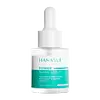What's inside
What's inside
 Key Ingredients
Key Ingredients

 Benefits
Benefits

 Concerns
Concerns

 Ingredients Side-by-side
Ingredients Side-by-side

Water
Skin ConditioningGlycerin
HumectantButylene Glycol
HumectantIsohexadecane
EmollientSodium PCA
HumectantPolyacrylamide
Citrullus Lanatus Fruit Extract
Skin ConditioningHylocereus Undatus Extract
Skin ConditioningGlycyrrhiza Glabra Root Extract
BleachingAloe Barbadensis Leaf Juice
Skin ConditioningPhenoxyethanol
PreservativeC13-14 Isoparaffin
EmollientLaureth-7
EmulsifyingPanthenol
Skin ConditioningFomes Officinalis Extract
Skin ProtectingMilk Protein
Skin ConditioningPhragmites Karka Extract
Skin ConditioningPoria Cocos Extract
Skin ConditioningSodium Benzoate
MaskingSodium Hyaluronate
HumectantAllantoin
Skin ConditioningPolysorbate 20
EmulsifyingTriethanolamine
BufferingBisabolol
MaskingCarbomer
Emulsion StabilisingTetrasodium EDTA
Parfum
MaskingWater, Glycerin, Butylene Glycol, Isohexadecane, Sodium PCA, Polyacrylamide, Citrullus Lanatus Fruit Extract, Hylocereus Undatus Extract, Glycyrrhiza Glabra Root Extract, Aloe Barbadensis Leaf Juice, Phenoxyethanol, C13-14 Isoparaffin, Laureth-7, Panthenol, Fomes Officinalis Extract, Milk Protein, Phragmites Karka Extract, Poria Cocos Extract, Sodium Benzoate, Sodium Hyaluronate, Allantoin, Polysorbate 20, Triethanolamine, Bisabolol, Carbomer, Tetrasodium EDTA, Parfum
Water
Skin ConditioningNiacinamide
SmoothingSaccharide Isomerate
HumectantGlycerin
HumectantHydroxyethyl Urea
HumectantPentylene Glycol
Skin ConditioningBetaine
HumectantBiosaccharide Gum-1
HumectantCentella Asiatica Leaf Extract
Skin ConditioningPropanediol
SolventPhenoxyethanol
PreservativePEG-40 Hydrogenated Castor Oil
EmulsifyingInositol
HumectantHydroxyethyl Acrylate/Sodium Acryloyldimethyl Taurate Copolymer
Emulsion StabilisingPolyacrylate Crosspolymer-6
Emulsion StabilisingPEG-7 Glyceryl Cocoate
EmulsifyingAllantoin
Skin ConditioningSodium Hyaluronate
HumectantDisodium EDTA
Lactic Acid
BufferingLactobacillus/Collagen Ferment Filtrate
HumectantPanthenol
Skin ConditioningTocopheryl Acetate
Antioxidant1,2-Hexanediol
Skin ConditioningCeramide NP
Skin ConditioningHydrogenated Lecithin
EmulsifyingCitric Acid
BufferingSodium Citrate
BufferingXanthan Gum
EmulsifyingGlycine Soja Sterols
EmollientSodium Polygamma-Glutamate
Emulsion StabilisingHyaluronic Acid
HumectantHydrolyzed Hyaluronic Acid
HumectantHydrolyzed Sodium Hyaluronate
Skin ConditioningHydroxypropyltrimonium Hyaluronate
Potassium Hyaluronate
Skin ConditioningSodium Acetylated Hyaluronate
HumectantSodium Hyaluronate Crosspolymer
HumectantChlorphenesin
AntimicrobialWater, Niacinamide, Saccharide Isomerate, Glycerin, Hydroxyethyl Urea, Pentylene Glycol, Betaine, Biosaccharide Gum-1, Centella Asiatica Leaf Extract, Propanediol, Phenoxyethanol, PEG-40 Hydrogenated Castor Oil, Inositol, Hydroxyethyl Acrylate/Sodium Acryloyldimethyl Taurate Copolymer, Polyacrylate Crosspolymer-6, PEG-7 Glyceryl Cocoate, Allantoin, Sodium Hyaluronate, Disodium EDTA, Lactic Acid, Lactobacillus/Collagen Ferment Filtrate, Panthenol, Tocopheryl Acetate, 1,2-Hexanediol, Ceramide NP, Hydrogenated Lecithin, Citric Acid, Sodium Citrate, Xanthan Gum, Glycine Soja Sterols, Sodium Polygamma-Glutamate, Hyaluronic Acid, Hydrolyzed Hyaluronic Acid, Hydrolyzed Sodium Hyaluronate, Hydroxypropyltrimonium Hyaluronate, Potassium Hyaluronate, Sodium Acetylated Hyaluronate, Sodium Hyaluronate Crosspolymer, Chlorphenesin
 Reviews
Reviews

Ingredients Explained
These ingredients are found in both products.
Ingredients higher up in an ingredient list are typically present in a larger amount.
Allantoin is a soothing ingredient known for its protective and moisturizingg properties. Because of this, it is often added to products with strong active ingredients.
Studies show higher concentrations of this ingredient can promote wound healing.
Though it can be derived from the comfrey plant, allantoin is produced synthetically for cosmetic products to ensure purity.
Learn more about AllantoinGlycerin is already naturally found in your skin. It helps moisturize and protect your skin.
A study from 2016 found glycerin to be more effective as a humectant than AHAs and hyaluronic acid.
As a humectant, it helps the skin stay hydrated by pulling moisture to your skin. The low molecular weight of glycerin allows it to pull moisture into the deeper layers of your skin.
Hydrated skin improves your skin barrier; Your skin barrier helps protect against irritants and bacteria.
Glycerin has also been found to have antimicrobial and antiviral properties. Due to these properties, glycerin is often used in wound and burn treatments.
In cosmetics, glycerin is usually derived from plants such as soybean or palm. However, it can also be sourced from animals, such as tallow or animal fat.
This ingredient is organic, colorless, odorless, and non-toxic.
Glycerin is the name for this ingredient in American English. British English uses Glycerol/Glycerine.
Learn more about GlycerinPanthenol is a common ingredient that helps hydrate and soothe the skin. It is found naturally in our skin and hair.
There are two forms of panthenol: D and L.
D-panthenol is also known as dexpanthenol. Most cosmetics use dexpanthenol or a mixture of D and L-panthenol.
Panthenol is famous due to its ability to go deeper into the skin's layers. Using this ingredient has numerous pros (and no cons):
Like hyaluronic acid, panthenol is a humectant. Humectants are able to bind and hold large amounts of water to keep skin hydrated.
This ingredient works well for wound healing. It works by increasing tissue in the wound and helps close open wounds.
Once oxidized, panthenol converts to pantothenic acid. Panthothenic acid is found in all living cells.
This ingredient is also referred to as pro-vitamin B5.
Learn more about PanthenolPhenoxyethanol is a preservative that has germicide, antimicrobial, and aromatic properties. Studies show that phenoxyethanol can prevent microbial growth. By itself, it has a scent that is similar to that of a rose.
It's often used in formulations along with Caprylyl Glycol to preserve the shelf life of products.
Sodium Hyaluronate is hyaluronic acid's salt form. It is commonly derived from the sodium salt of hyaluronic acid.
Like hyaluronic acid, it is great at holding water and acts as a humectant. This makes it a great skin hydrating ingredient.
Sodium Hyaluronate is naturally occurring in our bodies and is mostly found in eye fluid and joints.
These are some other common types of Hyaluronic Acid:
Learn more about Sodium HyaluronateWater. It's the most common cosmetic ingredient of all. You'll usually see it at the top of ingredient lists, meaning that it makes up the largest part of the product.
So why is it so popular? Water most often acts as a solvent - this means that it helps dissolve other ingredients into the formulation.
You'll also recognize water as that liquid we all need to stay alive. If you see this, drink a glass of water. Stay hydrated!
Learn more about Water